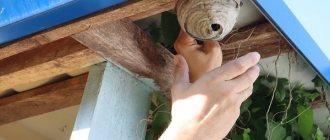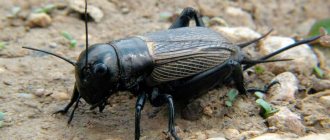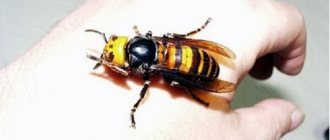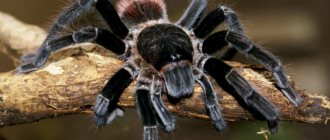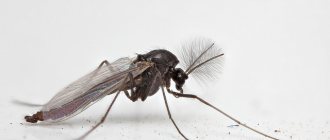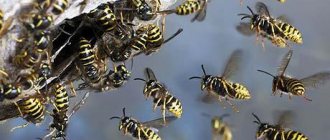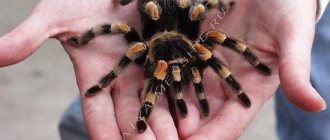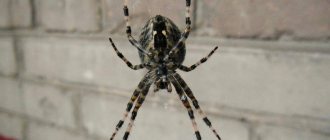Spider with cocoon
Surely many of you have met a spider running along the ground with some strange white ball stuck to its abdomen? This is how mother spiders carry a cocoon of spider webs with eggs, from which spiderlings will hatch in the future. In the photo you can see a female wolf spider (Lycosidae) with beautiful gray-brown fur and a white cocoon with spider eggs attached to her abdomen. If you look at this cocoon enlarged, it looks like a white golf ball. The eggs protruding under the cover of a dense web form tubercles similar to the bumps of a golf ball. Interestingly, the web cocoon is used for offspring even by those spiders that do not weave hunting webs, but simply hunt, like the wolf spider captured in the photo.
After fertilization, the female looks for a secluded place. There she weaves a spherical cocoon where she lays her eggs. The female wolf spider wears the cocoon on her body for several weeks, where it is attached to the tip of the abdomen using a spinneret. The rate of egg development depends on temperature, so the expectant mother begins to spend a lot of time in the sun, and not hide in the shade during the day, as before.
When a female wolf spider is carrying eggs, she spends a lot of time in the sun, as the eggs develop faster at high temperatures. Due to dehydration, she sometimes loses up to 30% of her weight! But the maternal instinct is stronger, and the female endures this torment for the sake of the offspring.
If a cocoon with eggs is taken away from a female, she will still experience anxiety for several hours and wander around the place where the cocoon was taken from her, in search of her offspring. A female whose cocoon has been taken away may carry a piece of cotton wool or even plasticine instead. There is a known case when a female Pardosa riparia, a small species, began to carry a cocoon of a much larger species of Pardosa amentata, which was four times larger than her own!
When the spiderlings emerge from the eggs, the mother breaks the cocoon with her powerful jaws-chelicerae, and the spiderlings, one by one, move onto her back. When the very first spider leaves the cocoon, it leaves a web along which all its brothers and sisters climb onto the mother. Until their first molt, they do not get off their mother's back and do not eat anything. Then the female finds a suitable damp, shaded place, the spiderlings descend to the ground and begin to live on their own.
The nervous system of wolf spiders is one of the most developed of all spider species. This is due to their rather complex lifestyle - the need to hunt prey, complex mating rituals and the process of bearing offspring.
For anyone who wants to read in more detail about the process of gestation of eggs in wolf spiders, I recommend an article on the website nature.rf
Additional photos: A few more photos of the spider with a cocoon
During the mating period, it is necessary to create certain conditions for both the male and the female.
In order to prevent the male’s sperm, located in the pedipalps, from drying out, it is necessary to envelop him with care from the moment he matures and properly monitor the humidity. She can even be tall, it won’t bother him in any way. Also at such a moment he needs strength and therefore nutrition should be at the appropriate level. But often males refuse food when they become sexually mature.
The important fact is that if more than six months pass after molting, then the male in most cases will not be able to fertilize the female!
The female needs significant reserves of fat and protein, for this her nutrition is no less important than that of the male. It is possible to allow food to be constantly in her terrarium, especially when she is in a cocoon, but there are always exceptions, for example, in a species such as: Pterinochilus murinus.
A really important question arises on the topic of mating. How to determine when and exactly how long a female is ready to mate? And is she mature?
When the male has woven sperm-webs into the pedipalps, sperm has already been collected, then he is ready for fertilization. This occurs approximately 2-4 weeks after molting. And this can be said for sure.
But we cannot give exact facts about the female. It can be approximated by age and size. Because of this, it is very good to keep some kind of diary, which will contain information about the spider’s molting. Or after the female has woven a false cocoon.
The result of mating, as we know, is a cocoon. But the interesting thing is that after mating there will not always be exact fertilization. It may often happen that after copulation, eggs are not laid; after a short time, the female molts (along with the shed skin, the remaining sperm in the spermatheca will be removed during molting). Also shocking is the data that cocoons can be laid, but they will be unfertilized (this may be the case with Theraphosa blondi). It is also interesting to know that females of Poecilotheria regalis, Psalmopoeus cambridgei, etc. can lay eggs without mating, and naturally they will be unfertilized. At the same time, the maternal instinct awakens in females. They kindly look after the cocoon, groom and cherish it. Why is this all happening? So far no one has been able to answer this question. Scientists only assume that the possible cause of such a failure may be the habitat, humidity and air temperature, and seasonal changes.
Before placing spiders of different sexes in a terrarium, you need to do several things. You need to take rectangular cardboard (necessarily thick) or a long flattened stick. They will serve as a shield. It’s just that sometimes one-on-one spider attacks happen.
Evening and night are the most favorable times for males to reproduce; they become very active. In order to add heat to the fire, you can increase the air temperature in the terrarium and the humidity level. To prevent the female from simply eating the male, you need to feed her heartily some time before mating.
There are several very good methods for mounting tarantulas.
1. You need to place the female on the opposite side of the container from the male. In order not to scare away the spider, you need to move it there in a small container. After some time, we can see open interest in the male. But it also happens that no one wants to take the first step. In this case, you need to take a stick and just start stroking the pedipalp and front legs of both spiders in turn. If we don't see any results, we'll simply push the female closer, perhaps this way we can arouse interest. When mating begins, you need to keep your finger on the pulse, because the male may need help at any moment. You just need to be very careful, because you can damage the tarantulas.
2. If you want to place a male in a closed terrarium with a female, then you just need to place him opposite her in the terrarium. All that remains is to observe.
If you do not see any results, then the best option would be to repeat the replanting in a few days.
Since during mating the male takes the initiative, to calm his soul it is better to place the female next to him and leave him alone. Although Hysterocrates spp., Haplopelma spp. and some other species are not subject to these rules.
Some owners, so that their spider does not get shocked, place two terrariums side by side. He looks closely for a couple of days to get acquainted with the situation, and then the door is opened slightly for him to sit down.
If everything went well, then the female wraps her eggs in a cocoon. Before this whole process, she weaves almost the entire cell with a web and digs holes. Most often he chooses a place in the corner and sets up his “nest” there. If you want the mother to take care of her offspring after the cocoon hatches, then you need to fulfill all her whims. If you want to incubate the cocoon yourself, then you need to pick it up 8-10 days after plexus, or on the 45th day, when there will be stage 1 nymphs or, on the 54th day, when the nymphs will be stage 2.
Many books describe the process of removing the cocoon, but S. and M. Schultz tend to use a spoon. He warns that you need to be extremely careful.
There are several reasons for a female to successfully lay a cocoon. Some species prefer to stay in places with low temperature and humidity after mating. This period can last from two to three weeks (Grammostola rosea), only such temperature changes should be smooth and gradual.
This method works very well for the reproduction of tropical species of spiders (this method is applied to Brachypelma vagans).
However, this method asks more questions than it gives any recommendations. Therefore, no one has yet been able to draw any conclusions.
Understanding the Strengths of the Class
The Rogue has a percentage boost to Counterattack, Evasion, Critical Chance, and Critical Damage. A special trait of the Trickster is vampirism. With its help you can recover right during a fight. However, it is very difficult for a robber to get good equipment. At the very beginning of the game, he often gets bad items.
Defense is the Dodger's weak point!
If a necromancer can ensure his own safety by summoning skeletons, and a warrior thanks to rapid regeneration, then with a robber things are different. You'll have to rely as much as possible on evasion. However, it's not all bad. As you progress through the game, the Trickster will improve his own characteristics and find new skills. This will make him feel much better in battle.
Nest creation process
Building a nest for a female tarantula is a very important moment. In most cases, individuals prefer the far corners of the aquarium to place their nests in it. It is very important to have a support on which the web will be attached from different sides.
When the spider has decided on its location, it begins to weave a kind of hammock. After the female completes the construction process, she begins to gradually lay eggs at the very bottom of her nest.
In appearance, the eggs resemble a yellowish paste, on which you can see small eggs of various sizes and shapes. The spider's belly gradually decreases in size and takes on a devastated appearance. Gradually the female forms a hammock shape, creating a spherical appearance.
In order for the future offspring to be healthy and strong, it is important to monitor the temperature in the terrarium while the incubation process is taking place. If the humidity level exceeds acceptable standards, the eggs may begin to rot. In this case, the mother can eat them.
What is a 3rd grade doll?
The pupa is an intermediate stage of development of insects that undergoes a complete transformation in the process of ontogenesis (see Metamorphosis). The insect does not feed and is usually motionless, but intensive internal restructuring occurs in it, during which the insect transforms from a larva into an adult—Imago.
Interesting materials:
What are viruses created for? Why do they light candles for the health of enemies? What is a scanner for? Why sprinkle salt on the doorstep? Why was there a window in the hut? Why Wi-Fi in an air conditioner? Why are Alpacas bred? Where is the most protein in the table? Where can I spend points from my Tinkoff card? Where is NFC located in Redmi 9?
Best skills
The robber has many useful skills. To start the game, it is recommended to take “ Sharpie ”, as this will allow you to build an additional “ Thicket ” or another “ River ”.
- “ Sharpie ” gives you a 10% chance to keep any card after placement. The only thing is that the effect of the skill does not affect gold cards.
- “ Picky ” is a wonderful option for a robber. The character will receive fewer items, but their value will increase. This will help you obtain useful equipment in the future, so this skill is extremely important.
- “ Nothing is sacred ” is also effective. Restores 3 HP for destroying an enemy unit. The result will be a kind of improved vampirism. Thanks to this skill, the Trickster can fight multiple opponents without any problems.
Best Equipment
Improving your magic reserve is an initial necessity. Therefore, the robber will need to stock up on amulets. Next, you can collect equipment and bet on critical chances and damage from attacks.
Don't forget about evasion. This characteristic is an important component when conducting combat. The logic is simple: the more opponents miss, the faster the character will be able to deal with the enemies.
Experiments and consequences: spider cocoons
Home→Tasks→One-time→ Experiments and consequences: spider cocoons
| brief information |
| Job Type: Determines whether the current job can be taken again. One-time |
| Start:Name of the NPC who is giving the current quest. Imarek (Vicinities of Lyubech) |
| End: The name of the NPC who ends the current quest. Imarek (Vicinities of Lyubech) |
| Previous Quest: A list of quests that must be completed or taken to obtain the current quest. If there are several tasks, it is worth understanding how the logic works AND , and in some cases OR .
|
Next task: A list of tasks that will be available after completion or during the completion of the current task.
|
Description:
Find spider cocoons north of the settlement where scout Imarek is located, in square L8, and collect 10 samples for scientists. Then take them to the scout.
Execution process:
Four clutches of cocoons are scattered across square L8-3 (3 large clutches and 1 small), another small clutch of cocoons is located in the northeast corner of square K8-4.
The map is loading...
{"minzoom":false,"maxzoom":false,"mappingservice":"leaflet","width":"300px","height":"200px","centre":false,"title":"", "label":"","icon":"Marker-flag.png","lines":[],"polygons":[],"circles":[],"rectangles":[],"copycoords" :false,"static":false,"zoom":3,"defzoom":14,"layers":["Outlands"],"image layers":[],"overlays":[],"resizable": false,"fullscreen":true,"scrollwheelzoom":true,"cluster":false,"clustermaxzoom":20,"clusterzoomonclick":true,"clustermaxradius":80,"clusterspiderfy":true,"geojson":"" ,"clicktarget":"","imageLayers":[],"locations":[{"text":"","title":"","link":"","lat":7.88515,"lon ":65.56641,"icon":"/w/images/1/1e/Marker-flag.png"},{"text":"","title":"","link":"","lat ":10.48781,"lon":69.87305,"icon":"/w/images/1/1e/Marker-flag.png"},{"text":"","title":"","link" :"","lat":9.18887,"lon":71.2793,"icon":"/w/images/1/1e/Marker-flag.png"},{"text":"","title": "","link":"","lat":4.82826,"lon":74.00391,"icon":"/w/images/1/1e/Marker-flag.png"},{"text":" ","title":"","link":"","lat":5.00339,"lon":69.69727,"icon":"/w/images/1/1e/Marker-flag.png"}] ,"imageoverlays":NULL}
After examining all 5 clutches and collecting 10 cocoon samples, return to Imark.
Beware of spiders, stay alert.
Reward:
Experience: The pure amount of experience indicated (without the learned perks 'Increasing Intelligence' and without premium)
Survival: 10,000 experience points Support: 10,000 experience points
Reputation:
(-10 Mission neutrality is the sum of reputation points received as a reward for the current task. This number allows you to understand how generally positive or negative the completion of the current task is relative to all factions)
| Merchants: | 30 | reputation |
| Hucksters: | -30 | reputation |
| Bandits: | -100 | reputation |
| Military: | 30 | reputation |
| Mercenaries: | 30 | reputation |
| Hunters: | 30 | reputation |
| Scientists: | 30 | reputation |
| Cultists: | -30 | reputation |
Trade Points:
Imarek: 20 trade points Pavel Petrovich: 10 trade points
It is important to know:
- If you cancel/fail a task from the One-time category, you can take it again after 12 hours, and if abused, some characters will completely stop issuing such a task (forever).
- If you cancel/fail a task from the Reusable category, you can take it again after the time marked as frequency has elapsed. The time after which it will be possible to retake the current task of such a task.
- Canceling a quest or failing it in some cases will result in a penalty in the form of reputation and/or experience.
Small deck
The Rogue is most vulnerable early in the game. Therefore, it is recommended to focus all your efforts on just a few cards. One or two keys will do. You won’t even have to waste your energy on the rest.
You shouldn't rely on quantity here - it's much better to focus on the quality of the cards.
“ Bookstore ” is suitable for the initial draw. Also, don’t be afraid to use “ Spider Cocoon ”. By the way, it’s worth adding a few words about this card, because it plays a special role in the Trickster build.
Spider cocoon
This may seem like a pretty scary card. However, you should not immediately have a negative attitude towards “ Spider Cocoon ”. Because it is useful in its own way.
Several spiders will appear on the way at once. The enemies are not easy for a rogue, but due to their number, you can get a whole bunch of useful cards. After all, the more enemies, the more loot. Therefore, you should not be afraid of the “ Spider Cocoon”. On the contrary, it is better to play this card as quickly as possible.
Forge shop
The Rogue obtains equipment through the trophy system. Each enemy drops a token, which is then exchanged for weapons and armor. But at the same time, the robber does not always receive effective items for combat. So this card will be an excellent solution to this problem.
“ Blacksmithing ” allows you to turn useless equipment into a powerful buff that reduces damage taken. The Rogue initially has problems with defense, so the defensive effect would be a great addition to the character's items.
Arsenal
The map will be unlocked along with the smelter. Adds an additional slot to the character for placing amulets. Therefore, in the future there will be fewer problems with the amount of magic the Trickster has. This is a very important characteristic. When choosing a new amulet, you should pay attention to the increased bonus to magic. If you choose correctly, this will allow the robber to no longer return to this indicator.
Other characteristics of the Trickster are improved with the help of other equipment.
Mountains and Dunes
Very similar cards in effect. “ Mountain ” increases the robber’s health, and “ Dunes ” reduces the HP of all opponents. It is recommended to use both to make the battle easier.
Mountain cards have a negative effect. If you place them on a 3x3 square, then harpies will inevitably begin to spawn there. They can cause a lot of problems for the character, especially early in the game.
Forest and Thicket
“ Forest ” in conjunction with “ River ” is very useful. The latter doubles the effect of cards located nearby. You can also use “ River ” together with “ Thicket ”. This will increase attack speed by as much as 4% (instead of 2%). Since the robber has a very good indicator, it makes sense to place a full bet on him.
There is a special combination with “ Dunes ”! In conjunction with “ Thicket ,” it turns out that the character’s attack speed increases, while that of monsters, on the contrary, decreases. This combo allows you to deal with even the strongest opponents.
Brief description of eggs and cocoon
Spiders lay eggs in a web cocoon. It consists of two layers, between which there is a loose layer.
The web protects the masonry from the following dangers:
- drying out;
- mechanical damage;
- bacteria;
- parasites;
- fungi;
- temperature jumps.
Basically, spider eggs consist of a nutritious yolk. They are covered with chorion and vitelline membrane. Quite elastic to the touch. With strong mechanical stress, the shell is very easy to destroy.
The color of the shell may vary depending on the species. In the nests of different species you can find almost all the colors of the rainbow, in addition, these colors can be very bright.
Some eggs are poisonous to mammals. Moreover, their toxicity does not depend on the degree of toxicity of the spider that carried them. An animal that eats such a clutch may die.
The cocoon consists of a web, which is why it is painted white, but can have different shades. Sometimes spiders coat their webs with a special enzyme, which makes the shell dense. It protects the masonry from moisture and bacteria.
Spiders can hide cocoons:
- on the ground;
- under fallen leaves;
- under stones;
- attach to branches.
In some species, the web does not reflect ultraviolet light or reflects only some spectra, due to which the cocoon becomes visually less noticeable among the foliage.
